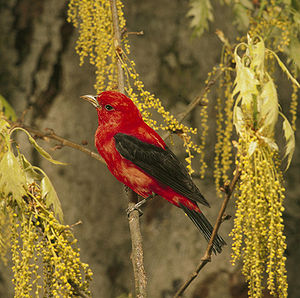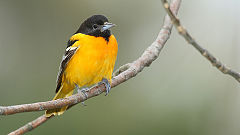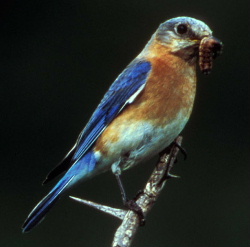|
EGGSHELLAND
We Can Fly_
Easter, April 4, 2010
32,741 Real Eggshells
Eggshelland
is a unique Easter Display, presented by Ron and Betty Manolio of Lyndhurst,
Ohio. This
will be our 52nd year. The entire front yard is transformed into different eggshell
mosaic designs each year, always
including a 50ft. Cross and our mascot, the Easter Bunny.
The display has grown
from 750 shells in 1957. We use 24 brilliant
colors of 1Shot, Outdoor
Sign
Paint enamel to paint the shells. As far as we know, it is the only
display of it's kind in the
world. The idea came from Ron's Mother, who placed dyed eggshells on bushes in front of her home.
This is a family
project. We used to save our shells. We now get our eggshells from the
Sidewalk Cafe,
who use fresh eggs. Without them the display
would not continue, as other
restaurants use liquid eggs. Ron
makes a hole the size of a dime in the
egg and Betty shakes out
the
contents. The shells are then washed and the edges of the hole trimmed. After painting, the
shells are stored by
color in boxes, with 250 in each box. They are used over and over
again each year, and
repainted, if necessary, in the proper
colors.
Our average handling
breakage is 1500 shells. We have had five natural disasters.
In 1998, and
2009, hail storms destroyed 18,000
shells.
In 2002, an ice storm on 6 inches of snow
broke 11,941, in 2005,
6 inches of snow smashed 5,633 shells, and in 2007 16
inches of
snow on Easter morning broke 14,176. In
2008, for the first
time, we were not able to put pegs in
the
lawn, because the ground was frozen. Our Display consisted of
6,223
eggshells, using the
five figures we have on Styrofoam, usually
standing
in the background.
The
theme this year is We Can Fly .
The display includes; Scarlet Tanager, with 4,630
shells,
Goldfinch, Oriole, Bluebird, with
6,823 shells, and Hummingbird with 2,401 shells.
We always receive
excellent local coverage, and in 2000,
we appeared on the Montel Williams
Show, and were also featured on Extreme
Cuisine, and the Agri-Country Network. We have been f
eatured on
"Ripley's Believe it or Not," and a photo was sent
out by Associated Press that
reached as
far as the front page of an English language newspaper
in Japan. We were on
the "Today Show" Easter morning 2006, and
CNN in 2007. A documentary on Eggshelland, which has
taken
4 years to complete, will have it's DVD Release Party at the Cedar-Lee
Theater, in Cleveland
Heights, on March 27 at 7:30 PM. The
display is lit at night, and will be
up from March 27 thru
April 5th.
Happy Easter!
Ron and Betty Manolio
NEW EGGSHELLS
1031 Linden Lane
Courtesy of
Lyndhurst, Ohio 44124
Sidewalk Cafe - Painesville
(440) 442-6061
Sidewalk Cafe - Euclid
Creative Eggshell Displays
- Lectures
Nick J. Sarris
Directions: From intersection of
Richmond Road and Ridgebury - make three left turns on Roland, Ashwood
and Linden Lane.
For more information
about
the film "Eggshelland" the Movie -

 Webcam at Cleveland Metroparks Zoo.
Webcam at Cleveland Metroparks Zoo.
A view of Wade Hall at Waterfowl Lake, one of the oldest
zoo buildings in North America, constructed in 1884.

The Scarlet Tanager (Piranga olivacea) is a
medium-sized American songbird. Formerly placed in the tanager family
(Thraupidae), it and other members of its genus are now classified in
the cardinal family Cardinalidae. The
species's plumage and vocalizations are similar to other members of the
cardinal family. Adults have pale stout smooth bills. Adult males are
bright
red with black wings and tail; females are yellowish on the underparts
and olive on top, with olive-brown wings and tail. The adult male's
winter plumage is similar to the female's, but the wings and tail
remain darker
A striking black-winged red bird, the Scarlet Tanager is a
common species of the eastern forest interior. Despite its brilliant
coloring it is often overlooked because of its rather secretive
behavior and its preference for the forest canopy
Hummingbirds are birds comprising the family Trochilidae.
They are among the smallest of birds, and include the smallest extant
bird species, the Bee Hummingbirds. They can hover in mid-air by
rapidly flapping their wings 12–90 times per second (depending on the
species). They can also fly backwards, and are the only group of birds
able to do so. Their English
name derives from the characteristic hum made by their rapid wing
beats. They can fly at speeds exceeding 15 m/s (54 km/h,
34 mi/h).
The American Goldfinch (Spinus tristis), also known as
the Eastern Goldfinch and Wild Canary, is a North
American bird in the finch family. It is migratory, ranging from
southern Canada to North Carolina during the breeding season, and from
just south of the Canadian border to Mexico during the winter.

New World orioles, comprising the genus Icterus,
are a group of birds in the Icteridae family. They are not
related to the Old World orioles which are in the family Oriolidae, but
are strikingly similar in size, diet, behaviour and their
yellow-and-black plunage, a good example of convergent evolution,
and almost inevitably took the same vernacular name. The males are
typically black and yellow or orange, with
white markings; the plumage of females and immature birds is duller.
These birds go through one moult in a year. They are generally slender
with long tails and a pointed bill.

The bluebirds are a group of medium-sized, mostly
insectivorous or omnivorous birds in the genus Sialia of the
thrush family (Turdidae). Bluebirds are one of the few thrush genera in
the Americas. They have blue, or blue and red, plumage. Female birds
are less brightly colored than males, although color patterns are
similar and there is no noticeable difference in size between sexes.
|